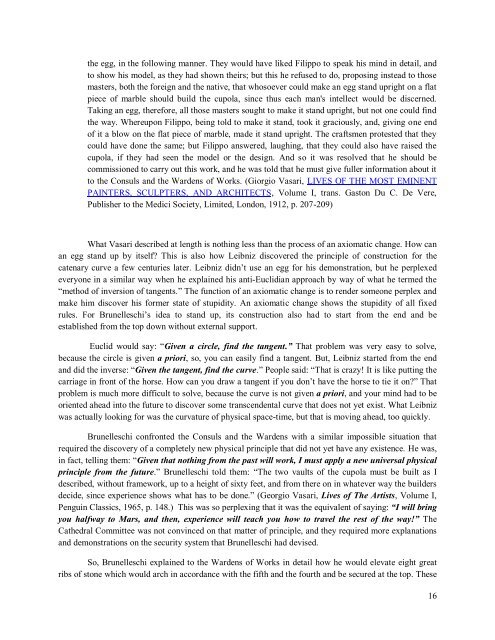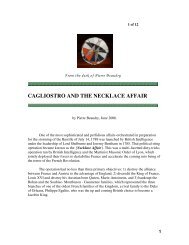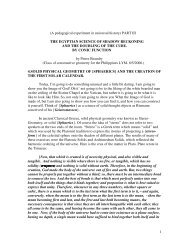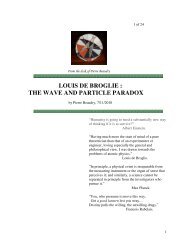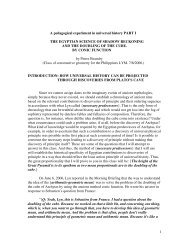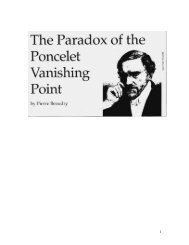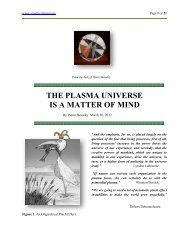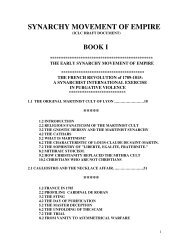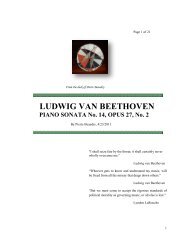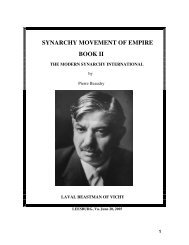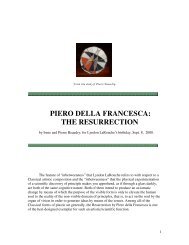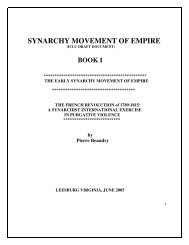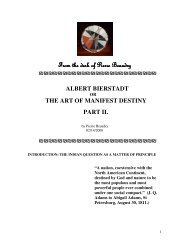filippo brunelleschi's mind and the catenary principle - Pierre ...
filippo brunelleschi's mind and the catenary principle - Pierre ...
filippo brunelleschi's mind and the catenary principle - Pierre ...
You also want an ePaper? Increase the reach of your titles
YUMPU automatically turns print PDFs into web optimized ePapers that Google loves.
<strong>the</strong> egg, in <strong>the</strong> following manner. They would have liked Filippo to speak his <strong>mind</strong> in detail, <strong>and</strong>to show his model, as <strong>the</strong>y had shown <strong>the</strong>irs; but this he refused to do, proposing instead to thosemasters, both <strong>the</strong> foreign <strong>and</strong> <strong>the</strong> native, that whosoever could make an egg st<strong>and</strong> upright on a flatpiece of marble should build <strong>the</strong> cupola, since thus each man's intellect would be discerned.Taking an egg, <strong>the</strong>refore, all those masters sought to make it st<strong>and</strong> upright, but not one could find<strong>the</strong> way. Whereupon Filippo, being told to make it st<strong>and</strong>, took it graciously, <strong>and</strong>, giving one endof it a blow on <strong>the</strong> flat piece of marble, made it st<strong>and</strong> upright. The craftsmen protested that <strong>the</strong>ycould have done <strong>the</strong> same; but Filippo answered, laughing, that <strong>the</strong>y could also have raised <strong>the</strong>cupola, if <strong>the</strong>y had seen <strong>the</strong> model or <strong>the</strong> design. And so it was resolved that he should becommissioned to carry out this work, <strong>and</strong> he was told that he must give fuller information about itto <strong>the</strong> Consuls <strong>and</strong> <strong>the</strong> Wardens of Works. (Giorgio Vasari, LIVES OF THE MOST EMINENTPAINTERS, SCULPTERS, AND ARCHITECTS, Volume I, trans. Gaston Du C. De Vere,Publisher to <strong>the</strong> Medici Society, Limited, London, 1912, p. 207-209)What Vasari described at length is nothing less than <strong>the</strong> process of an axiomatic change. How canan egg st<strong>and</strong> up by itself? This is also how Leibniz discovered <strong>the</strong> <strong>principle</strong> of construction for <strong>the</strong><strong>catenary</strong> curve a few centuries later. Leibniz didn’t use an egg for his demonstration, but he perplexedeveryone in a similar way when he explained his anti-Euclidian approach by way of what he termed <strong>the</strong>“method of inversion of tangents.” The function of an axiomatic change is to render someone perplex <strong>and</strong>make him discover his former state of stupidity. An axiomatic change shows <strong>the</strong> stupidity of all fixedrules. For Brunelleschi’s idea to st<strong>and</strong> up, its construction also had to start from <strong>the</strong> end <strong>and</strong> beestablished from <strong>the</strong> top down without external support.Euclid would say: “Given a circle, find <strong>the</strong> tangent.” That problem was very easy to solve,because <strong>the</strong> circle is given a priori, so, you can easily find a tangent. But, Leibniz started from <strong>the</strong> end<strong>and</strong> did <strong>the</strong> inverse: “Given <strong>the</strong> tangent, find <strong>the</strong> curve.” People said: “That is crazy! It is like putting <strong>the</strong>carriage in front of <strong>the</strong> horse. How can you draw a tangent if you don’t have <strong>the</strong> horse to tie it on?” Thatproblem is much more difficult to solve, because <strong>the</strong> curve is not given a priori, <strong>and</strong> your <strong>mind</strong> had to beoriented ahead into <strong>the</strong> future to discover some transcendental curve that does not yet exist. What Leibnizwas actually looking for was <strong>the</strong> curvature of physical space-time, but that is moving ahead, too quickly.Brunelleschi confronted <strong>the</strong> Consuls <strong>and</strong> <strong>the</strong> Wardens with a similar impossible situation thatrequired <strong>the</strong> discovery of a completely new physical <strong>principle</strong> that did not yet have any existence. He was,in fact, telling <strong>the</strong>m: “Given that nothing from <strong>the</strong> past will work, I must apply a new universal physical<strong>principle</strong> from <strong>the</strong> future.” Brunelleschi told <strong>the</strong>m: “The two vaults of <strong>the</strong> cupola must be built as Idescribed, without framework, up to a height of sixty feet, <strong>and</strong> from <strong>the</strong>re on in whatever way <strong>the</strong> buildersdecide, since experience shows what has to be done.” (Georgio Vasari, Lives of The Artists, Volume I,Penguin Classics, 1965, p. 148.) This was so perplexing that it was <strong>the</strong> equivalent of saying: “I will bringyou halfway to Mars, <strong>and</strong> <strong>the</strong>n, experience will teach you how to travel <strong>the</strong> rest of <strong>the</strong> way!” TheCa<strong>the</strong>dral Committee was not convinced on that matter of <strong>principle</strong>, <strong>and</strong> <strong>the</strong>y required more explanations<strong>and</strong> demonstrations on <strong>the</strong> security system that Brunelleschi had devised.So, Brunelleschi explained to <strong>the</strong> Wardens of Works in detail how he would elevate eight greatribs of stone which would arch in accordance with <strong>the</strong> fifth <strong>and</strong> <strong>the</strong> fourth <strong>and</strong> be secured at <strong>the</strong> top. These16


